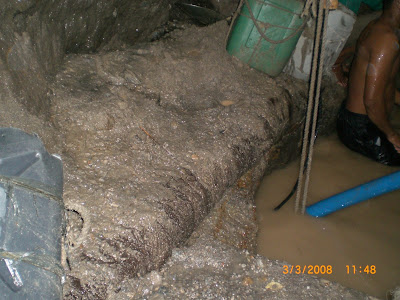
The team have finally resumed the search down.
We are working on a dome like area. At the bottom we are using plywood box caisson with wooden framing to constraint the excavation area. This way, we can go down faster too.
With this only one man is required to work inside. His buddy would pile up and fill the bag with sand and to be stock piled by the other two men. The team works on a buddy system although there is only one man on the top of the dig who handles the winch and acts as the look out and surface support.
The excavated sand is being filled up in the bags and being stock piled on top of the box for a while. The pile bags filled with sand act as weight that will help sink the wooden box as the bottom is being excavated.
Then the accumulated sand bags are being transferred at the higher stocking area at the back of the retaining bamboo fences. This way, and unlike the previous operation last year, there is no need to bring the excavated sand to the top of the dig. Rather it is being piled up within the working area in the bottom of the dig to augment the retention of sand inside and in return to prevent the chances of further bar down. The most important consolation is lesser work for the members of the digging team.
Another interesting observation, is that once water dries inside the wooden box, there was a sudden surge of water like bubbling that penetrates from the surrounding ground/sand. The previous theory that there is a natural underground water source that is passing through our area of excavation may not be the real situation.
For all we know the Japs always included in their sites man-made water traps which they usually sourced from near-by bodies of water. A small stream in our case.
The team will try to locate the source of the water trap from a upstream side of the stream which was theorized to be within the vicinity of the waterfall.
Indeed, searching for the eluded YTh is never an-easy task.
We, nevertheless, have still our high hopes that this year, will be the year!










